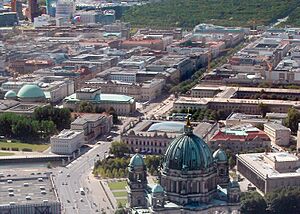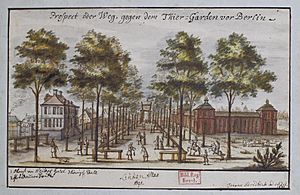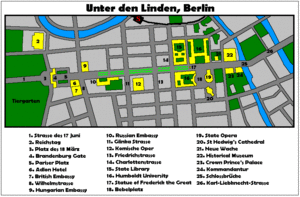Unter den Linden facts for kids

Unter den Linden from Berlin Cathedral to Brandenburg Gate and Tiergarten park, view from Fernsehturm, 2005
|
|
| Lua error in Module:Location_map at line 416: Malformed coordinates value. | |
| Former name(s) |
|
| Part of |
|
| Namesake | Linden trees |
| Type | Boulevard |
| Length | 1,480 m (4,860 ft) |
| Width | 60 m (200 ft) |
| Location | Berlin, Germany |
| Quarter | Mitte |
| Nearest metro station |
|
| Coordinates | Lua error in Module:Coordinates at line 614: attempt to index field 'wikibase' (a nil value). |
| West end |
|
| Major junctions |
|
| East end |
|
| Construction | |
| Inauguration | 1573 |
Unter den Linden (which means "under the linden trees") is a famous street in the center of Berlin, Germany. It's like a grand avenue, about 1.5 kilometers long. The street gets its name from the beautiful linden trees that grow along its middle section.
This important street connects many of Berlin's famous places. It runs from the Berlin Palace all the way to the iconic Brandenburg Gate. Along the way, you can see many historical buildings and landmarks.
A Walk Through History
Unter den Linden started as a simple path in the 1500s. A ruler named John George, Elector of Brandenburg used it to reach his hunting grounds. Later, in 1674, a queen named Dorothea Sophie helped turn it into a grand boulevard. She even planted some of the first linden trees herself!
Over time, Berlin grew, and Unter den Linden became the city's most important street. Many beautiful buildings were constructed along its sides. One famous statue, the equestrian statue of Frederick the Great, was placed there in 1851. It shows a powerful king on horseback.
During World War II, many of the linden trees were sadly destroyed. But after the war, in the 1950s, new trees were planted. Today, the street is once again lined with these lovely trees, making it a green and welcoming place.
Famous Places to See
As you walk along Unter den Linden, you'll find many interesting spots. Starting from the east, near the Schlossbrücke (Palace Bridge), you can see:
- Alte Kommandantur: This building, at number 1, was once a military headquarters.
- Zeughaus: At number 2, this is the oldest building on the street. It was built between 1695 and 1706 and is now home to the Deutsches Historisches Museum, a German history museum.
- Crown Prince's Palace: This was once the home of the royal princes.
- Neue Wache: At number 4, this building is a memorial to victims of war and violence. It was designed by a famous architect, Karl Friedrich Schinkel.
- Bebelplatz: This historic square is surrounded by grand buildings.
- Berlin State Opera: Often called Lindenoper, this is a beautiful opera house.
- St. Hedwig's Cathedral: A large Catholic church.
- Altes Palais: This "Old Palace" was a favorite home of Emperor Wilhelm I.
- Humboldt University: At number 6, this is one of Berlin's oldest and most famous universities. You can see statues of famous brothers, Alexander and Wilhelm von Humboldt, in front of it.
- Berlin State Library: A huge library with many books and documents.
- Russian Embassy and Hungarian Embassy: These are the official buildings for these countries in Berlin.
- Hotel Adlon: A very famous and luxurious hotel right next to the Brandenburg Gate.
At the very end of Unter den Linden, you'll reach the magnificent Brandenburg Gate. This gate is a symbol of Berlin and German history.
Images for kids
-
Neue Wache (New Guard House) memorial
-
Berlin State Opera, one of several neoclassical buildings on Bebelplatz
-
Main building of Humboldt University
-
Brandenburg Gate at Pariser Platz, which marks the western terminus
See also
 In Spanish: Unter den Linden para niños
In Spanish: Unter den Linden para niños
- Berlin Brandenburger Tor station – formerly Berlin Unter den Linden
- Berlin Unter den Linden station – U-Bahn station at the Friedrichstraße intersection, served by U5 and U6 trains

















